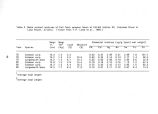| OCR Text |
Show III. L. 2. Management alternatives. Alternative A: No action A regulatory structure is in place governing the evaluation of oil and gas lease applications that includes assessing environmental impacts to water resources. However, there is no set of standards to include in leases and operating permits that would ensure compliance with water resource protection requirements. Continued lack of such standards under this alternative would result in development of lease standards on a case- by- case basis, and, consequently, in uncertain protection of water resources from oil and gas development impacts. Lack of an adequate information base on water resources would continue to hamper the evaluation of mineral- lease applications and could result in over- or underestimating potential impacts. Alternative B: Develop lease and operation standards for water resource protection ( preferred alternative) Standard language to govern leasehold operations would be developed to ensure water resource protection. The stipulations would be included in each lease or operating permit and become part of the legal requirements for development. The standards would ensure maintenance of natural flows and the quality of potentially affected waters, whether ground water or surface water. Mitigation of all impacts would be required. Existing standards of state and federal agencies would be reviewed and supplemented as needed by lease standards specific to the recreation area. Standards for leasing, exploration, development, production, and abandonment would be covered in the review. Three standard lease stipulations specifically proposed under this alternative are the following: 1. no drilling will be permitted within one- quarter mile of any spring or seep; 2. abandoned wells or drill holes must be cemented from the bottom to the surface; and 3. natural flows of water must be maintained in all operating areas. 56 |








































































































